The Plundered Life: Elizabeth Graham's Fight for Justice in East Jersey, Middlesex County
- Denise Rompilla
- Mar 24
- 3 min read

In the winter of 1776, Elizabeth Graham encountered British soldiers and Tory raiders out
of desperation in defense of what little she had left. Her home, in Middlesex County, in what was then referred to as East Jersey, would join the long casualty list to be torn apart by the bedlam of battle and looted. To Elizabeth, this was not a war fought upon some battlefield but within her walls.
While Hessians, British troops, and Loyalist forces stormed through East and West Jersey, they would not miss any house that came along their path; Elizabeth's story vividly reminds us of the toll this war would take on civilians, particularly the womenfolk, who suffered at the brutal hands of this violence.
A Woman's Loss in the Revolutionary Chaos
In her inventory of damages, Elizabeth Graham recounted the devastating losses she endured at the hands of the British and their allies. The enemy took everything from fine jewelry, silver tableware, and watches to furniture and cash from her home. One entry lists a "Negro fellow named Oliver," an enslaved man taken or coerced away by the Hessians during their passage through Middlesex County.
These losses were not just material: to Elizabeth, each of these pieces taken away reflected a little bit of the family's wealth, security, and identity. And even with threats, she precisely documented the things taken away from her; she knew it would be her only recourse for getting compensation and seeing justice done.
The Night of Terror
The most harrowing was when, on December 19, 1776, a band of British soldiers identified
as the Queen's Rangers, led by several Tory refugees, descended on the Graham residence. George H. Fisher, so bold as to refer to himself as "Barracks Master of the Jersey Blues," conducted his soldiers in razing the premises. She recalled that they found and broke a chest hidden in the barn containing jewelry, watches, and silver. Despite her pleading for mercy, the soldiers forced Elizabeth and her husband, Ennis, at bayonet-
point, and thrust them back into the house. The terror was so high that Elizabeth described standing with "bayonets fixed close to her breast" until the looters
left.
Days later, Ennis Graham made his desperate effort to recover some of their property and traveled to Brunswick, never to return, for he died shortly after. Now a widow, Elizabeth had to bear the heavy responsibility for looking for fairness on behalf of her family.
Women Victims, Women Fighters
Elizabeth Graham's story is typical of the hardships women faced during the Revolutionary War. Her husband's executrix, Elizabeth was responsible for handling his estate, which included the property stolen during the war. In so doing, she had to navigate the legal system in filing claims for restitution-a process that required dogged determination, fearlessness, and an unyielding belief in the possibility of justice.
Women like Elizabeth were victims and fighters in equal measure during this period. The
Revolution tore their lives apart, leaving them without economic security and at the mercy of violence. However, as Elizabeth's inventory and testimony attest in detail, women resisted such injustices and put their voices on record for posterity.
Broken Promises of the Revolution
The case of Elizabeth Graham puts a painful punctuation on yet another truth about the
Revolutionary War: that its promise of liberty and justice, to say the least, stopped far short of the lives most torn apart by its violence. Fought for freedom, it did little to defend someone like Elizabeth - her property and person notwithstanding - as if either side was indifferent. Her war damage claim reflects together personal resilience and the deeper ways in which the failures of the Revolution to make its ideals a reality left visible scars. For women, for people like Oliver, for so many, the Revolution as often exchanged one type of oppression for another.
Elizabeth Graham's fight for justice is one of those myriad stories yet to be spoken about
the Revolutionary War. The inventory of her losses now stands as testimony to what women had to bear and endure in this era of turmoil. While the soldiers who plundered her home would take everything, they could from her, what they could not take was the determination to record, resist, and seek compensation. Elizabeth's story forces us to rethink, considering those carrying its heaviest loads, the promises of the Revolution and its failures. It reminds us that the struggle for justice often continues long after the battles have ended.
Primary Source: New Jersey State Archives, Trenton, NJ, Damages by the British, volume 4, Middlesex County, 1777.




Comments